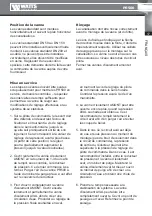
PR500
2
Table of contents
Page 2 Operation
Page 2 Mounting
Page 3 Installation
Page 3 Drawing PR500
Page 4 Maintenance
Page 4 Pressure Reducing Control Pilot
263 AP
Mounting
Mounting must be carried out, as far as
possible, according to the drawing below.
The choice of the proper “by pass” alterna-
tive must be taken considering the following
points:
a.
Can the main transport/feeding line be
put out of service during some hours
(corresponding to the requested time for
maintaining the MAIN VALVE), without
generating problem for the exploitation
of the system? In particular, it must be
considered that an empty system may
require several days to be vented
properly.
b.
Has the downstream zone of the system
to be protected against any risk of
pressure surge (quick closing of heavy
demands, closing time of pressure redu-
cing valve)?
In order to get the best accuracy from the
pressure reducing valve operation, the
pre-set values for the reduced downstream
pressure should be included in the indicated
range of the pilot valves. If it is very near to
the extreme limits of replace the spring by
the correct one.
Operation
The pressure reducing valve PR500 is
controlled by a normally open diaphragm
actuated two ways, spring loaded, adjustable
pressure reducing control pilot, set to
maintain a constant outlet pressure from the
main valve.
The set point of the downstream reduced
pressure, which is sensed under the pilot
diaphragm, is adjustable within the indicated
spring range of the pilot.
As downstream pressure increases, the
diaphragm pushes against the spring,
allowing the pilot poppet loaded by an
auxiliary spring to be pulled towards its
closed position, ristricting the fl ow through
the pilot. This allows the main valve to
modulate towards closing. In this way
the valve controls downstream pressure
increase carrying it back to adjusted values.
As downstream pressure decreases,
the control pilot throttles towards open,
modulating the main valve toward open.



































